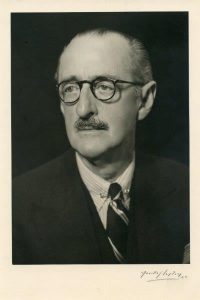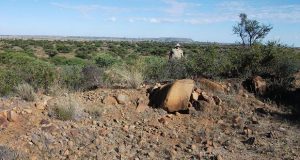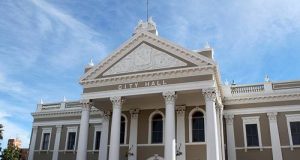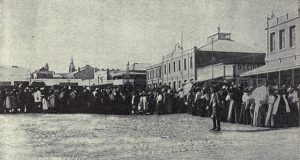12 September 1944, Lt Lafase Moolman dies after his Oxford aeroplane crashes during night training at 21 Air Flying School.
12 September 1949, Claude Benette kills Frederick Scholtz opposite the West End cemetery.
The murder near the West End cemetery
The discovery of a corpse, burnt to discourage identification – found buried in a shallow grave between Koffiefontein and Fauresmith on 12 September 1949 – really galvanized the police in the Orange Free State and in Kimberley, and they moved very rapidly indeed.
The corpse was discovered by a Black labourer midway between the diamond-mining town of Koffiefontein and the picturesque village of Fauresmith on the farm Telegraphfontein, some 21 kilometres from Koffiefontein. There had been an attempt to destroy the corpse by burning it with petrol, and there appeared to be two bullet wounds in the head. The labourer had seen a white man making a fire in a gully some 12 metres from the road and when he had departed, went to investigate and found the body. He had noted that the man’s car was black and that it had a Cape Province registration number.
The police were notified and within a short time Captain N.E. Parker from Koffiefontein was on the scene, and by the following day – Tuesday – had already identified the body as that of a Port Elizabeth resident, one Frederick Clement Scholtz. Indeed, the police, using the information given by the African and some local farmers, were moving so rapidly that by Thursday 13 September, Claude Bernard Benette, driving a Port Elizabeth registered 1934 Chevrolet CB 6661, had been arrested in Graaff-Reinet by Head Constable I.P. Gous, and already appeared in the Koffiefontein Magistrate’s Court before Mr A.C. Beyleveld on a preparatory charge of murder. He was remanded in custody until 11 October, and in the ensuing investigation, was committed for trial on a charge of murdering Scholz.
At the same time as Benette appeared in court for the preliminary hearing, Scholtz was being buried in the small cemetery in Mafeking (Mahikeng), the funeral being from the Dutch Reformed Church on what is now Mandela Road. His stepfather and mother, Mr and Mrs A.J. O’Reilly, his brother J. Scholtz and the murdered man’s daughter Marjorie, were the main mourners. The police already knew that Scholtz had been killed on an isolated plot of land near the fence of the West End municipal nursery and directly opposite the West End cemetery. At the spot of the murder, pools of blood were found.
The trial began on 2 March 1950 in the Free State village of Fauresmith, the small courtroom being packed with interested townfolk, mostly women. It was indeed a big event for the community and people who could not get seats stood at the doorways and even looked through the windows. Justice E.M. de Beer, the Judge-President of the Orange Free State presided over a jury, the Prosecutor was H.F. de Wet, with P.J. Rabie appearing for the defence.
The court heard that Claude Benette, a motor mechanic, and Scholtz had traveled up from Port Elizabeth together and had stayed at the Central Hotel in Koffiefontein as from 7 September. Scholtz, according to Abraham Apple, the owner of the hotel, had lots of money, but complained all the time about Benette and his attitude. Benette, a slightly built man, was dressed smartly in a brown sports coat and grey flannelled trousers. In one buttonhole of the jacket he wore a disabled soldiers badge of 1914-1918, and in another an Ex-serviceman’s badge.
The two men had been friends for many years despite the fact that the 35 year old Scholtz was considered by all with whom he had contact, to be an aggressive person. He had threatened his wife – who had left him some six weeks before he was killed – and his employees with violence on numerous occasions. Mrs Gertruida Barry, formerly married to Scholtz for nine years before divorcing him, said that he had been a most unreasonable man and very short tempered. She had left him on at least four occasions because of his behaviour before terminating their marriage.
Scholtz and Benette had both left Koffiefontein early on 12 September to go into Kimberley, but only Benette returned to the hotel that night in order to book out. Upon Apple enquiring where Scholtz was, Benette told him that on the way into Kimberley Scholtz had hit him twice, and that he had later given Scholtz a “good smack”. He also said that Scholtz had decided to stay in Kimberley. Not one to keep a secret for very long, Benette also told bar customer Andries van Tonder Joubert, when asked about Scholtz, that: “I bumped him off.”
The two comrades, having completed their business earlier that day in Kimberley, stopped at a vacant plot opposite the West End cemetery on Green Street, and as usual, according to Bennette, they were having an argument. Benette had taken out a tin of sardines for lunch and was trying to open it with a screwdriver and hammer when Scholtz told him to leave the sardines for now, and to rather rest first, and then eat. The hungry Benette told him that he was going to eat when he wanted to, and not when told to.
According to Benette, the ever-argumentative Scholtz then said that “but for the respect he had for my parents, he would blow my brains out.” Virtually immediately Benette lost his temper with Scholtz, telling him to leave his parents out of the conversation as it was he who had been responsible for the death of Benette’s father some years earlier. (Benette senior had died of shock after traveling with Scholtz, who appeared to be a most reckless and dangerous driver). The latter then kicked Benette who hit him with the hammer several times, Scholtz then countering with a bottle, but the blows to the head with the hammer proved fatal and Scholtz died on the ground in front of him.
At this stage of the trial, the accused broke down on several occasions. He had, he said, tried to bring Scholtz back to life by pouring water down his throat. He couldn’t believe that Scholtz was dead: “I do not know what possessed me to do such a thing.” Benette had then loaded the body, weighing some 158 pounds, into the boot of the car and drove to the spot between Koffiefontein and Fauresmith where he first attempted to burn it with petrol, and then buried it in a shallow trench. Apart from the Black person previously mentioned, a Fauresmith farmer, one S.J.W. Strauss, had seen the smoke in the bush and had investigated further, finding Benette next to the car. Strauss returned when Benette had left the scene and went to where he had seen the smoke, finding freshly turned soil. Upon digging a little, he had come across human remains and immediately called the police.
After listening to the final argument by both prosecution and defence, the jury retired for forty minutes before returning with a verdict of not guilty of murder, but guilty of the lesser charge of culpable homicide. Justice de Beer, before sentencing Claude Benette to five and a half years imprisonment, said that although there were mitigating circumstances, Benette had “exceeded the bounds of all reasonableness. You killed a human being. You thereafter disposed of the body.” The convicted man, who sobbed when the verdict was given and through the judgment, had retaliated when provoked by Scholtz, but this was not his undoing.
His real crime, for he may well have been found not guilty of murder or indeed, of culpable homicide had he gone to the police immediately, was that he had tried to dispose of the body after the deed.
UPDATED: 12/09/2023
12 September 1944, Lt Lafase Moolman dies after his Oxford aeroplane crashes during night training at 21 Air Flying School.
12 September 1949, Claude Benette kills Frederick Scholtz opposite the West End cemetery.
Henry Percy (HP) Rudd was born on 5 December 1868 at Rondebosch, the first child and eldest son of Charles Dunell (CD) Rudd and his first wife Frances nee Chiappini. He was educated at Harrow and then Oxford, before further studies in Geneva with the intention of making a career in the Diplomatic Service. But in 1888 HP determined to join the army and enlisted with the Cape Town Highlanders. After serving probationary terms with the regular regiments then stationed at the Cape he was commissioned in the Royal Scots (Lothian Regiment), now part of the Royal Regiment of Scotland, in 1891, as Second Lieutenant. He saw service in Malta and England, and in 1894 was promoted to Lieutenant.
On 17 October 1893 HP married Mabel Blyth in the Parish Church at Bluntisham, Cambridgeshire. She was the third daughter of Matthew Smith Blyth, who was at one time chief magistrate of Griqualand East. The bride wore a dress of rich cream satin trimmed with fine old lace. Her veil was secured with a diamond spray, the gift of her father-in-law. The couple would have four children: Bevil Rudd (the Olympic athlete) born 1894, Mona, Jack born 1903 and Dolores born 1904. The last two children were born at the Bungalow (now known as ‘RUDD HOUSE’ in Kimberley).
In 1896 HP and Mabel came out to South Africa as, due to ill heath, HP could no longer serve in the army, and in 1897 he resigned his commission. They settled in Kimberley where the lease of ‘The Bungalow’ at 5 Loch Road, Belgravia, was transferred from CD Rudd to HP Rudd in 1898. In May 1900 HP was appointed as CJ Rhodes’ alternate on the board of De Beers Consolidated Mines Ltd. This was due to his father, who requested Rhodes to do so as HP was ‘not strong enough for regular work and is spoiling for some occupation and interest’. In July 1902 HP became a director in his own right and went on to serve in that position for 59 years, until his death. In 1960 HP summed up his view of Rhodes thus: ‘He was a weird animal. One moment he could be a baby and the next the complete reverse. But for all that he was a remarkable man, and there has never been anyone like him since’.
Apart from his involvement with De Beers HP was a director of several other companies including the New Jagersfontein Diamond Mining Co Ltd. When in Kimberley HP was driven to board meetings at the head offices of De Beers in Stockdale Street and along with him went a luncheon basket. Amongst the close friends of HP numbered Solly Joel and Sir Abe Bailey with whom he shared a passion for horse racing and the breeding of racehorses. His racing colours consisted of a sage green vest, red sleeves and a blue cap. Some of the horses in his stables in 1907 were Iolanthe, Veldt and Make-Up. In 1914 HP was vice president of Barkly West District Turf Club and in 1924 a vice-president of the Kimberley Turf Club.
HP was fond of sports in general, and animals, both keeping them and killing them. At ‘The Bungalow’ was an aviary housing mostly doves, and he had a pet parrot. In 1902, 1906 and 1907 he was a vice-president of the Griqualand West Poultry, Pigeon and Cage Bird Club, and by 1914 was a patron. HP was reportedly an excellent shot and during the hunting season regularly attended shoots at Rooipoort, the De Beers shooting box outside Kimberley. When in residence at his seaside home ‘Rocklands’ at St James (near Muizenberg) he went deep sea fishing from his motor launch. His sporting interests aside, HP was not involved in many civic or cultural organisations. He did serve on the management board of the Kimberley Hospital in 1914-1915.
He was a member of the Kimberley Club and entertained friends there and at the Bungalow.
Mabel Rudd died in 1927 in London and six years later Henry Percy married Miss Emilie Stephanie Poole of Ecully, an elegant city just west of Lyon France. Emilie had been housekeeper/ companion to Mabel and it seems stayed on with the family after her death. The wedding of HP and Emilie at the Brompton Oratory London on Saint Valentine’s Day 1933 was by all accounts quite an affair, and apparently all the adult female guests were given a diamond to commemorate the event. His second wife, affectionately known as ‘Mizi’, called her husband ‘Puggy’. To others he was known as Percy.
What was HP like as a person? He was always immaculately dressed and was rather vain. He liked fine wines. It seems from certain accounts that he was somewhat eccentric and as he got older became more so. Or perhaps he just had, like many people, certain habits and foibles that were remarked upon. It is evident that he liked his privacy. At St James he bought the properties on either side so that there would be no immediate neighbours. In Kimberley a granddaughter of Ellis Wynne Weatherby, who lived at 1 Loch Road and was a friend of HP, remembered as a little girl in the 1930s repeatedly ringing the bell at the front gate of ‘The Bungalow’, in Hemming Street, for fun. Somehow her father found out and she had to apologise to Mr Rudd in the drawing room of ‘The Bungalow’ where HP stood and admonished the little girl severely.
Henry Percy and Emilie lived at the Bungalow from the time of their marriage until 1954 when they moved to the Cape. HP died in the Volks Hospital Cape Town on 12 September 1961 at the age of nearly 92. The funeral was held at the Holy Trinity Anglican Church, Kalk Bay, and was, apart from family and friends, attended by many figures from the diamond mining industry, including Harry Oppenheimer who flew from Johannesburg to be present.
(Photographs McGregor Museum)
From Kimberley Calls and Recalls on Facebook By Steve Lunderstedt
Shortlink for this post: https://www.kimberley.org.za/?p=10598










